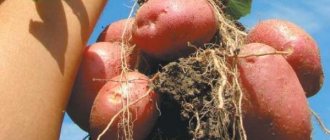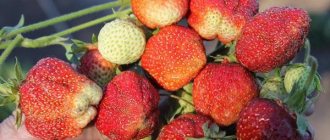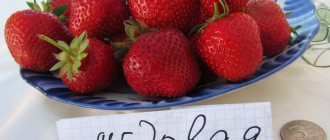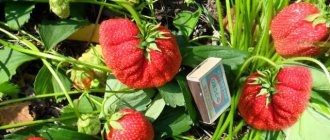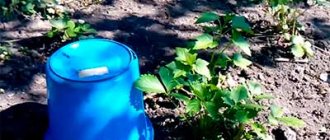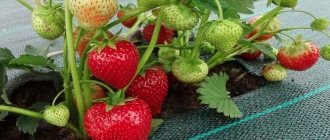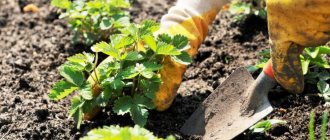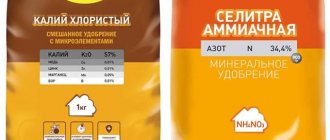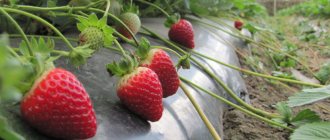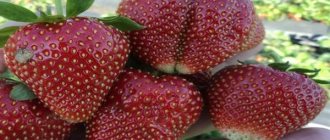Description of the variety
Bushes
Arosa bushes are not large in size and are quite compact. The rosette of leaves is moderately spreading, the leaves themselves are medium-sized, light green in color and slightly pubescent, like the petioles on which they are located.
The inflorescences are slightly raised above the leaves, they are distinguished by their large size and the even shape of the corolla.
Arosa forms an average number of tendrils, reproduces well, but does not produce dense plantings. The bush grows quickly, actively gaining strength and green mass during the first season.
Berries
Arosa fruits are different:
- orange-red color;
- pleasant aroma;
- juiciness and density;
- good keeping quality and transportability;
- average weight 40 g;
- seeds located at the same level with the pulp;
- white tips at the stage of technical ripeness.
The berries ripen gradually (starting from mid-June), they are collected in several waves at least once a week.
Productivity
On an industrial scale (with proper agricultural technology), the yield of Arosa strawberries is 220 c/ha.
Note: Considering that Arosa ripens somewhat later than other commercial varieties and has good transportability, it is profitable to grow it on an industrial scale.
general information
Berries with strawberry flavor.
Juicy pulp of medium density.
Commercial strawberry variety.
This variety was “born” in Italy. It is intended for distribution in subtropical, mild temperate continental climates. As a productive commercial crop, strawberries have become extremely popular in the CIS countries.
Important information about this variety is presented in the plate.
| Berry shape | Round-conical, correct, 1-dimensional. |
| Berry weight | 30–45 grams. |
| Berry color | Red-orange, close to scarlet. The shiny skin has some glossiness. |
| Taste | Sweet, with a pronounced strawberry aroma. There are unobtrusive wine notes. |
| Pulp | Quite juicy, has medium density. |
| Seeds | Slightly pressed, located flush with the pulp. |
| Arrangement of peduncles | Above foliage level. |
| Flowers | Quite large, the calyx is the same, there is a wreath. |
| Leaflets | Light green in color, slightly wrinkled, drooping edges. |
| Antennae formation | Moderate. |
| Reproduction | Fast. |
| Productivity per 1 ha | 220 c. |
| Fruiting | Mid June. |
| Winter hardiness | High. |
| Transportability | Good. |
Note! This variety is suitable for growing in forest-steppe conditions.
a brief description of
Advantages of the variety
- gradual ripening of berries, which allows you to create a berry conveyor;
- harvesting at a time when early varieties have already finished bearing fruit;
- high productivity;
- resistance to the most common “strawberry” diseases;
- high transportability;
- universal purpose.
Among the disadvantages, one can highlight the fact that the Arosa strawberry is created for a subtropical, mild climate. This is a European variety, which in our country grows mainly in the southern regions. When moving north, it requires shelter.
Landing
It is convenient to plant Arosa bushes both in spring and autumn. Planting dates depend primarily on the climate zone and the wishes of the gardener. When planting in the spring, the flowers formed in the current season must be removed so that the bush becomes stronger and develops a powerful root system. The site selected for this variety is:
- south or south-west direction (landing on a slope is possible);
- open to the sun, without shading or drafts;
- with low groundwater (at least 1 meter from ground level).
It is necessary to prepare the soil in advance by digging it and removing weeds. Loams and sandy loam soils with neutral acidity are well suited for planting. In case of high acidity, it is recommended to add lime or dolomite flour.
Note: Good precursors for strawberries are legumes, cereals, onions, garlic, and carrots. Arosa strawberries do not grow well after any members of the nightshade family.
You need to mark holes on the site, maintaining a distance between bushes of at least 30 cm, and between rows of 40 cm. A handful of the nutrient composition of humus, peat and mineral components is added in advance and mixed with the soil so as not to burn the strawberry roots.
Each plant is placed in the holes, straightening the roots and burying the seedling to the root collar, while the leaf buds should be on the surface. The ground under the bushes is thoroughly watered and mulched with peat or sawdust.
Note: Do not allow the roots to dry out before planting. They should be buried in a damp place or moistened in a clay mash (a mixture of mullein and clay).
Video
A garden specialist (Timashevsk) talks about the characteristics of the variety and the peculiarities of its cultivation in the following video:
Another video review:
For several years she worked as a television program editor with leading producers of ornamental plants in Ukraine. At the dacha, of all types of agricultural work, she prefers harvesting, but for this she is ready to regularly weed, pull, shed, water, tie, thin out, etc. I am convinced that the most delicious vegetables and fruits are those grown with your own hands!
Found a mistake? Select the text with the mouse and click:
In Australia, scientists have begun experiments in cloning several varieties of grapes grown in cold regions. Climate warming, which is predicted for the next 50 years, will lead to their disappearance. Australian varieties have excellent characteristics for winemaking and are not susceptible to diseases common in Europe and America.
Tomatoes have no natural protection against late blight. If late blight attacks, any tomatoes (and potatoes too) die, no matter what is said in the description of the varieties (“variety resistant to late blight” is just a marketing ploy).
“Frost-resistant” varieties of garden strawberries (more often simply “strawberries”) need shelter just as much as ordinary varieties (especially in those regions where there are snowless winters or frosts alternating with thaws). All strawberries have superficial roots. This means that without shelter they freeze to death. Sellers’ assurances that strawberries are “frost-resistant,” “winter-hardy,” “tolerates frosts down to −35 ℃,” etc. are deception. Gardeners must remember that no one has yet managed to change the root system of strawberries.
Both humus and compost are rightfully the basis of organic farming. Their presence in the soil significantly increases the yield and improves the taste of vegetables and fruits. They are very similar in properties and appearance, but they should not be confused. Humus is rotted manure or bird droppings. Compost is rotted organic remains of various origins (spoiled food from the kitchen, tops, weeds, thin twigs). Humus is considered a higher quality fertilizer; compost is more accessible.
It is believed that some vegetables and fruits (cucumbers, stem celery, all varieties of cabbage, peppers, apples) have “negative calorie content,” that is, more calories are consumed during digestion than they contain. In fact, only 10-20% of the calories received from food are consumed in the digestive process.
Humus is rotted manure or bird droppings. It is prepared like this: the manure is piled up in a heap or pile, layered with sawdust, peat and garden soil. The pile is covered with film to stabilize temperature and humidity (this is necessary to increase the activity of microorganisms). The fertilizer “ripens” within 2-5 years, depending on external conditions and the composition of the feedstock. The output is a loose, homogeneous mass with a pleasant smell of fresh earth.
Convenient Android applications have been developed to help gardeners and gardeners. First of all, these are sowing (lunar, flower, etc.) calendars, thematic magazines, and collections of useful tips. With their help, you can choose a day favorable for planting each type of plant, determine the timing of their ripening and harvest on time.
One of the most convenient methods for preparing a harvest of vegetables, fruits and berries is freezing. Some believe that freezing causes the nutritional and health benefits of plant foods to be lost. As a result of the research, scientists have found that there is practically no decrease in nutritional value when frozen.
Natural toxins are found in many plants; Those grown in gardens and vegetable gardens are no exception. Thus, the seeds of apples, apricots, and peaches contain hydrocyanic acid, and the tops and peels of unripe nightshades (potatoes, eggplants, tomatoes) contain solanine. But do not be afraid: their number is too small.
Strawberry Arosa, according to the description, reviews from gardeners and photos sent by them, is a promising variety for growing not only in garden plots, but also on large plantations. This is a medium-ripening commercial variety that produces a record harvest of tasty, sweet berries.
Growing and care
Watering
The Arosa variety is moisture-loving and, since the roots lie close to the surface, needs regular watering. Lack of moisture affects the harvest: the fruits become small and the berries become sour.
On large plantations, drip irrigation is recommended, and on small areas, watering with warm water at the root. The stream of water should not be strong so that the soil is not washed away and the root system is not exposed. After watering, it is important to loosen the soil and mulch the soil around the bushes with peat or straw.
Note: One of the popular methods of growing Arosa strawberries is planting on film or agrofibre. This technique allows you not only to retain moisture, but also to get rid of weeds. In addition, the dark film allows you to warm the soil and get an earlier harvest.
Loosening, weed control
Loosening of row spacing is carried out regularly, especially on loamy soils. The procedure helps ensure air access to the roots and retain moisture. You need to loosen the bushes carefully, since the roots lie close to the surface and are easily damaged.
Removing weeds allows you to avoid overcrowding of plantings and preserve light and nutrients in the soil. Dense weed vegetation increases the risk of developing diseases and pests.
Removing a mustache
Vegetative shoots or tendrils develop on strawberries from spring to autumn. It is especially important to remove them in a timely manner at the beginning of summer so that they do not draw on nutrients that should go towards the growth of berries. Autumn pruning is also important, as it allows the bushes to get stronger and better prepare for the winter. If it is necessary to renew the plantings, then you can leave two uterine shoots on the most powerful and healthy plants.
Top dressing
The Arosa variety is traditionally fed:
- in spring mineral or organic fertilizer with nitrogen;
- in summer and autumn - phosphorus-potassium mixture;
- during the growing season - with organic compounds and ash.
Feeding is carried out from 3 to 5 times. This amount is quite enough for abundant fruiting.
Pest and disease control
Strawberry Arosa is resistant to diseases, but is affected by pests. For prevention, it is treated with a solution of Fitosporin or Bordeaux mixture. If pests are found on leaves or berries, fungicides and insecticides are used. If the infection is not widespread, then folk remedies can save the situation.
Note: Chemical treatment can only be carried out before flowering and fruit set, otherwise it will simply not be possible to avoid toxic substances getting on the berries. Arosa fruits do not have a thick skin and absorb chemicals well.
Preparing for winter
Before wintering, the following activities are carried out:
- remove excess mustache;
- cut off old foliage;
- the roots are covered with earth;
- in temperate latitudes - cover with sawdust and agrofibre.
Before winter, only 30% of the total green mass is left. It is important to protect not the leaves from freezing, but the growing point and roots.
Seed germination technique
It is quite acceptable to propagate strawberries by seed. At the same time, growing seedlings is considered a very labor-intensive process.
Sowing time
To get strong seedlings, it is recommended to plant seeds in late January or early February. This will help you get strong plants that will produce a harvest in the summer.
Sowing in peat tablets
It is permissible to cultivate seedlings in peat tablets. First, they should be soaked in warm water. As it swells, place a strawberry seed in the center and cover with film.
Sowing in the soil
To plant crops, you should use containers filled with nutrient soil. It should be treated with a hot solution of potassium permanganate. Seeds are placed on top and covered with film or glass. The shelter should be opened daily to ventilate the plantings.
Picking sprouts
Seedlings are characterized by slow development. When 3-4 leaves grow on the bushes, they should be picked. It is recommended to carry out the procedure very carefully so as not to break the branches. After diving, the seedlings are moved to a lighted place.
Why don't the seeds germinate?
Seeds do not always germinate. The main causes of problems include the following:
- violation of stratification rules;
- embedment too deep;
- excessive dryness or waterlogging of the soil;
- poor quality planting material.
See also
Description and cultivation of Elizabeth variety strawberries, planting and care
Read
Reproduction
Strawberry Arosa produces good harvests for 3-4 years. Then the plantation needs to be updated by planting younger plants. For propagation, the mustache is used primarily, leaving 2-3 strong shoots on the best plants and rooting them. By autumn, the mustache is separated and planted in a permanent place. In the spring, the flowers of the seedlings are plucked off so that the bush becomes stronger and forms a strong root system.
If space allows, you can create a queen cell from adult plants. They are used exclusively to produce tendrils, so the buds from the mother plants are constantly cut off. The mustaches are rooted in cups: this makes it easier to replant them without damaging the root system.
Reviews
The main thing is not to plant Arosa next to another Italian - Clery. It is almost impossible to distinguish bushes by appearance. I determine which variety is only based on the timing of fruiting - Arosa bears fruit much later.
I chose for myself the three best varieties of strawberries: the earliest is Alba, then comes Arosa and late Malvina.
Strawberries of the Arosa variety, having undoubted advantages, are unsuitable for northern latitudes. Here, its cultivation is possible only in greenhouses. Therefore, northerners should pay attention to other varieties, and southerners should rejoice at the opportunity to grow and try a new strawberry flavor.
